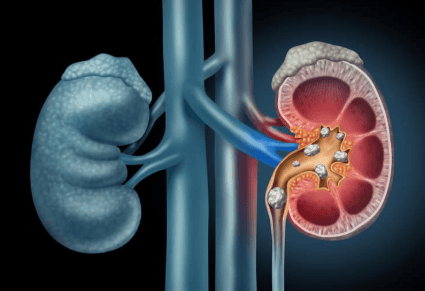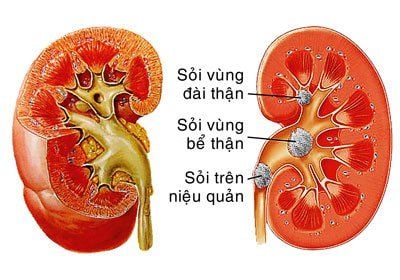This is an automatically translated article.
What are urinary stones, how are urinary tract stones formed, is the disease dangerous, ... are questions that many people are interested in. The following article will provide us with the necessary information around this issue.
1. How are urinary tract stones formed?
Urinary stones are a common disease, the main cause of renal colic. The process of formation and development of urinary stones is divided into the following 3 stages:
1.1. Early stage At this stage, new stones have arisen, moved and have not caused urinary obstruction, symptoms or complications. This phase usually lasts for about 2 years. When the stones first form, patients often have no symptoms or very faint symptoms, so they are often ignored. However, if urolithiasis is detected and treated promptly in this early stage, the effectiveness of urinary stone treatment will be up to 80%.
1.2. In this stage, the urinary stone has been blocked, does not move, causes symptoms and some complications such as pyelonephritis but has not caused serious complications, so it is still possible to restore kidney function. after removing the stone.
The obvious symptoms of urolithiasis at this stage are: pain and hematuria due to stone obstruction causing urinary retention, mild complications. If the disease is detected at this stage, doctors can apply minimally invasive methods to remove stones and not affect the patient's health much.
1.3. Late stage At this stage, urinary stones have caused serious complications such as infection, urinary retention, pyelonephritis, atrophic pyelonephritis, loss of kidney function,...

Quá trình hình thành, phát triển sỏi tiết niệu được chia thành 3 giai đoạn
2. Impact of stones on the urinary system
Stones cause damage to the upper urinary system in 3 basic ways: mode of compression, obstruction, method of cutting and rubbing, and mode of infection.
2.1. Obstructive mode This is the most common and also the most dangerous modality for renal function. When stones are located in locations prone to obstruction such as renal pelvis or ureter, depending on size and shape, stones can cause complete or incomplete obstruction, acute or chronic. If the blockage is suddenly complete, the kidneys will stop excreting. If this phenomenon occurs on both sides of the urinary system, the patient will fall into anuria due to stones. If the obstruction occurs incompletely and chronically, the renal parenchyma will gradually thin, the renal calyx capacity will increase, causing atrophy of the renal parenchyma and loss of kidney function. At the same time, the ureter on the stone is also dilated, causing loss of peristalsis and fibrosis of the ureter. If the stone is in the calyx, it is easy to cause local blockage in the kidney, leading to urinary retention, causing partial loss of kidney function.
2.2. This method is seen in patients with urinary stones that are hard, thorny stones (such as urate stones, oxalate stones). The stones can rub, cut into the organization of the kidneys and ureters, causing prolonged bleeding in the urinary system. This injury both increases the risk of UTIs and initiates the development of fibrosis in the renal parenchyma and the ureteral wall. As a result, kidney function will be affected, making urinary obstruction worse.
2.3. Mode of bacteriuria It is the upper two modes of obstruction and friction that increase the risk of developing bacteriuria. Urinary tract infection causes edema, deeper ulceration, accelerates the necrosis of renal tissue and urinary tract wall. The result is damage to kidney and ureter function.
Accordingly, the modes of action of the above urinary stones often combine with each other and lead to the eventual destruction of kidney function, distortion of the urinary system, and even death of the patient. .

Những phương thức tác động của sỏi tiết niệu bên trên thường kết hợp với nhau và dẫn tới hậu quả cuối cùng là phá hủy chức năng thận
3. Importance of urinary stone examination
The formation and progression of urinary stones can affect kidney function or even lead to death. Therefore, we should not be subjective about our health. If there are unusual symptoms such as pain, blood in the urine, painful urination, etc., you should perform a urinary system examination to detect and treat the disease early.Currently, Vinmec International General Hospital is providing a package of urological examination and screening, helping to detect the possibility of urinary diseases, especially prostate diseases and urinary stones. From there, patients will be consulted and supported in timely treatment, avoiding the risk of unpredictable complications.
Vinmec owns a modern ultrasound machine system, an advanced laboratory according to international standards, helping to detect lesions quickly and accurately. The hospital's top experts will provide direct advice and in-depth treatment for patients if abnormal problems are detected on the urinary system. Therefore, you can be completely safe when examining and examining urolithiasis here.
Please dial HOTLINE for more information or register for an appointment HERE. Download MyVinmec app to make appointments faster and to manage your bookings easily.













